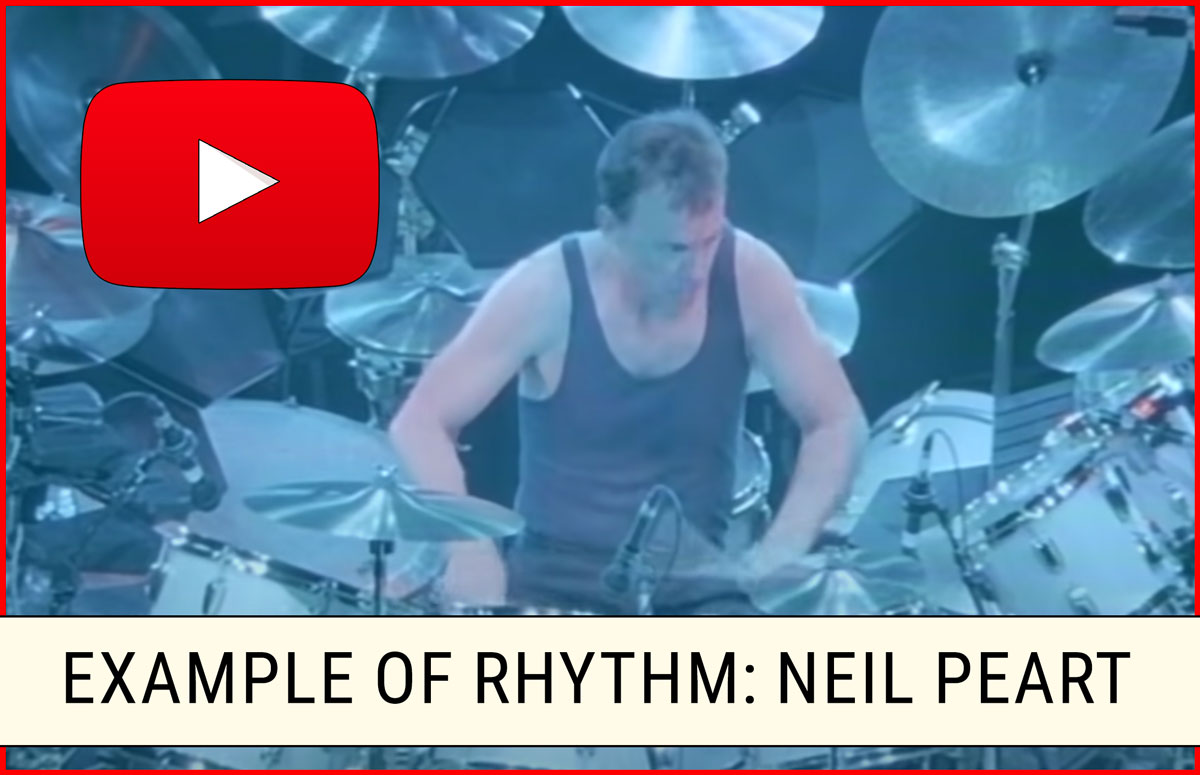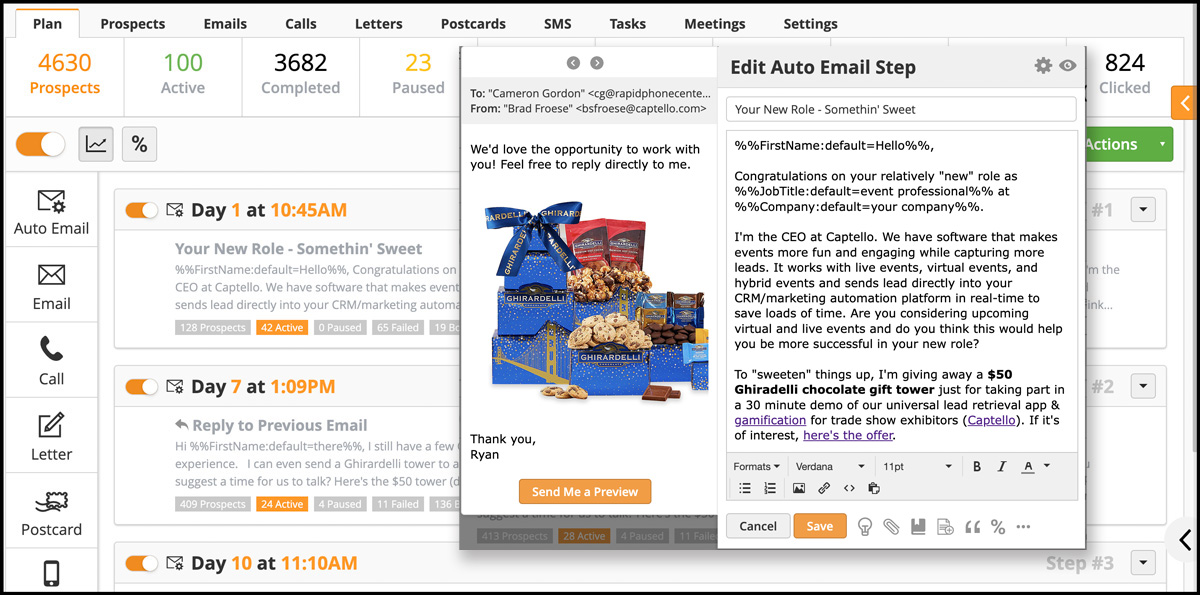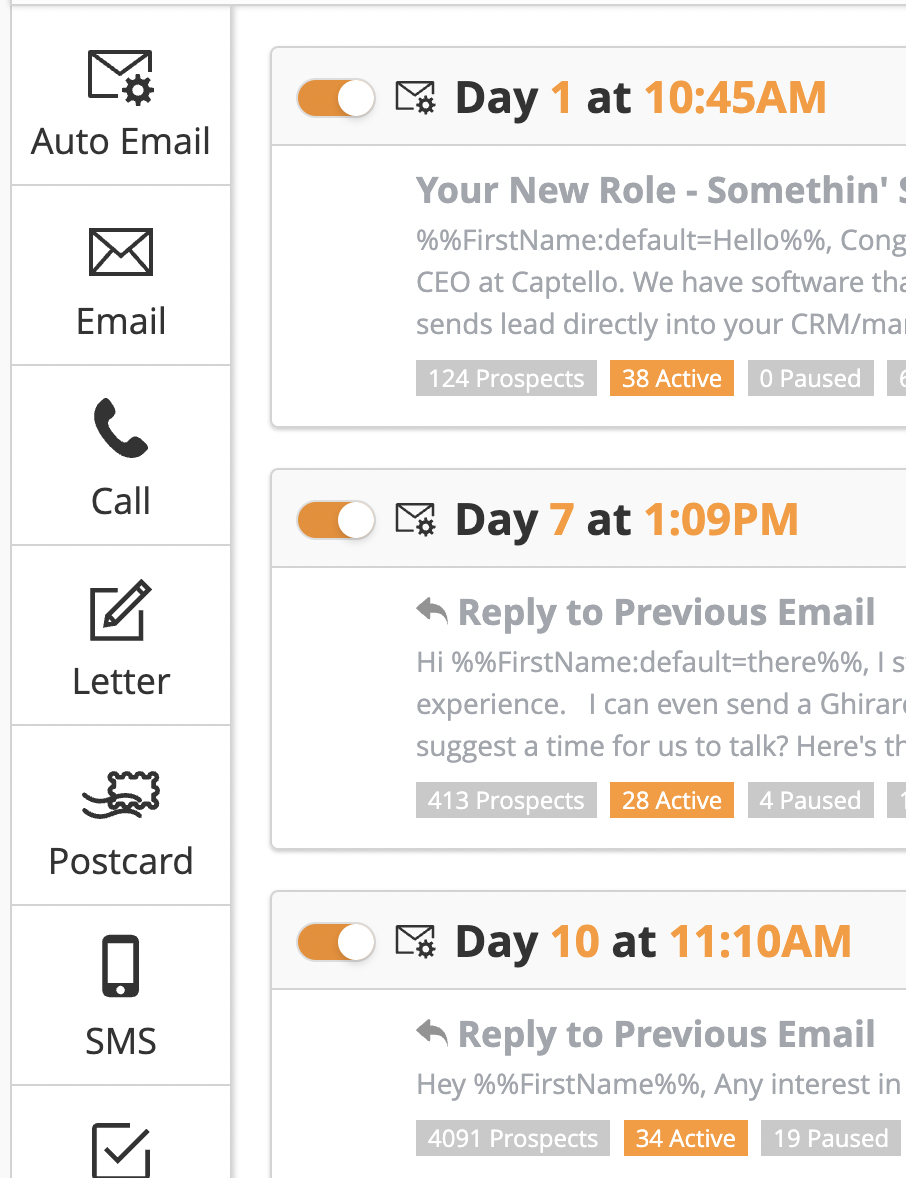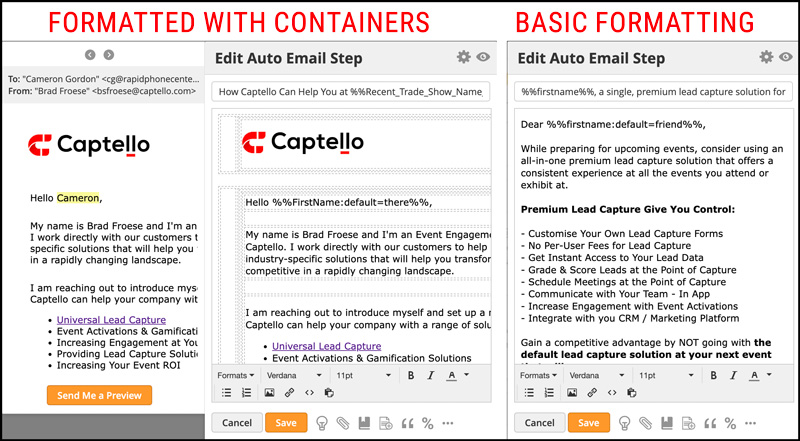Get The Most From Rhythms & Cadences
What is a rhythm?
To illustrate, give me 50 seconds of your time and watch this 1980’s video of the song YYZ. Begin at about 3:20 in:

YYZ is a seven minute showcase of musical talent composed and created by musicians who harnessed and refined their talent, forging it over time with discipline and practice.
Much like Neil Peart’s drum solo, a rhythm is a pattern or sequence of sounds (or events in our case) that combine to create a beautiful symphony.
The Symphony of Rhythms
When you combine all the automations and the rhythms and the calculations that the SaaS Platform Captello is executing for us and our customers every day, you don’t just have a mishmash of noise or actions; you have a showcase of synchronized talent that originates with your thoughts, plans, and words, and then goes out like an arrow to strike at the heart of who? Not just people, but unique individuals who just so happen to be called prospects to us.
This is why when we sit down to create a rhythm, we don’t just bang drums. We focus on the uniqueness of the individual and we try to reach them with solutions that accomplish their goals… Because honestly, every corporation wants their products to be SuperNova stars like Neil Peart…
And so when we sit down to create, or dream, or design a rhythm… and I use those words because really in marketing that’s what we have to do: create, dream, and design… We take the same position as an artist. We want to create something that reaches the heart of the reader. This process is the process of keeping it relevant to the person that we’re communicating to.
Just as we all watched Neil play and we all may recognize his talent, there are some of us to whom RUSH just is not relevant and in the same way, your message, as finely crafted as it may be, is not going to be relevant to everybody without focusing on their unique traits, their needs and their affinities. So focusing on the individual means we are searching for the unique factors that make Capello relevant to the people that we’re reaching out to.
Pulling Prospects from Data Sources
When I pull new prospects, I have a large list of criteria that can include geography, experience or position within the company, and so on. Prospect companies can be filtered by employee headcount, annual revenue, and so on. I want to tune these search criteria to make sure we’re always in the butter zone when we pull lead lists.
Once we download our leads, we further cull them until we have a list that says, “These are the people we need to talk to.” Always pull lead lists based on criteria that allows you to communicate to the right people, right where they are.
Personalization
How can I further drill down from here and really communicate to a specific segment of people?
For certain rhythms, we pull lists of people based on job changes or professional transitions. If data indicates that they were hired at a new job with titles matching our ICPs, and within a one year period, then we send them to a rhythm called, “The New ICP Less Than One Year Rhythm.”

This rhythm is really cool and unique. We’re actually sending an email straight from our CEO, Ryan Shefke, congratulating these people on their recent new position, which is highly relevant to them. It gets their attention and it does something else for us too… It gives us a reason to incentivize them for a conversation.
So these rhythms, because they’re focusing on a professional life event, get much higher response rates than other more broadly targeted rhythms.
And these rhythms are the basis of our Ghirardelli Incentive campaigns, or in the UK our Hotel Chocolat campaigns. So in marketing we offer incentives whenever we feel it’s right to do so, and Ghiradelli / Hotel Chocolat have been some of our all time high performing campaigns in terms of getting new demos. From the very inception of Capello, Ghirardelli incentives have really helped us to introduce our brand to people out there in the events industry.
Let me flip to a different rhythm in which I have targeted event professionals…
I was browsing social media one day and I noticed that there was a post in the UK where they were congratulating people for making the corporate A-list, and they were listing all the top winners; some 20 winners were all total event professionals who made it on C&IT corporate list.
So I created a special rhythm that spoke directly to that experience and congratulated them for their achievements. I wished them a wonderful stay in Scotland, the destination all the winners received a free trip to. I offered all of them a complimentary gift card and a fun gamification experience as our way of saying congratulations.
So now these winners are winning even more free stuff! They know Capello is benevolent and appreciates their professional development. And guess what? This approach with only 12 ICPs in the rhythm eventually led to a deal with AstraZeneca.
Adding Value to Build Relationships
If you’ve done everything you can to get information about people and you’re still falling a bit short in your personalization, rather than just solicit them with a straightforward approach, you should earn your right to approach them. Try to romance it some. Earn the right to approach them.
How do you do that?
Offer something they find value in, like a case study, video, or blog article that speaks to their interests and needs. As a general rule, don’t be pushy in your outreach emails. Keep it to a few carefully planned steps.

In this rhythm, we have a day-1 email scheduled first. Then we have a day-7 email, then day-10. We’re not going Day-1, Day-1, Day-1, Day-2, Day-5.
TIPS:
1: Keep your messages spaced out. Give your prospects a little time to breathe. Don’t be too salesy, and don’t be selfish in your outreach.
2: On the other hand, don’t be shy or passive. People want to know: why are you contacting them? You can let them know that you care and how you can help them, and you can do it in short and concise words or sentences.
3: Make your second message a follow up (reply to) to the first email you sent to keep the conversation alive. If you’re trying to reach out to somebody, would you create a brand new email each time and compose a new message every single time? No, you would go into your sent box, find the message you already sent, and build a history with a reply-to message. Build on that communication.
4: In your final email message, it’s ok to be less formal. This indicates you’re going to discontinue bothering them unless they show interest. You can even add a notice instead of a signature at the bottom: sent from my iPad. It’s obviously a little trick, but you want to come across as very human.
Important Note:
Rhythms are not marketing emails. Rhythm emails should be composed as if you had drafted them from your Gmail inbox or your Outlook inbox.
5: Another thing that has proven to be very effective in final messages is to offer choices to the recipient so they can quickly provide you with feedback, such as:
Choose one of these options:
1: I’m interested. Let’s talk soon.
2: I’m interested, but too busy right now.
3: I’m not interested at all.
Look to get closure on that last message, and keep it very brief.
A quick question came up during this session:
1: How does GDPR privacy law affect outreach to leads imported from LinkedIn Sales Navigator?
GDPR allows for cold email outreach if it is directly related to a business opportunity that is relevant to the recipient. So they need to be your ICPs, and it’s important to check that box before sending out any rhythm emails. These messages are going one to one, so it’s not sending in bulk like a marketing list. Rhythms are that totally personalized approach.
What happens if they haven’t responded?
What to do with prospects who don’t reply is totally up to your own discretion, since you know your prospects best. But I would give them a cool down period and then add them to a nurture campaign that educates them more about the brand and the offering so they can begin to understand their need for your solutions.
What we want to do in marketing is to create a reality for them. In order to create a new reality for a person, you have to present a relevant message to them from multiple different channels. They have to recognize that message coming from your brand within a specific timeframe. For example, within a one week period they hear your ad on the radio, then they see it on TV, and a few days later they receive a postcard… Now it’s becoming real to them.
This is why it’s important to add calls as part of a step in your rhythm. Ideally you would send an email, make a call, send an email, reach out with a handwritten letter… You’re mixing it up.
“People that send an email and call a few days later or a day after and say, “Hey, I sent you an email,” and they leave me a little message. Holy cow, it feels so much more real. I realize they’re human. I feel like they’re taking the time to prospect me, which I appreciate. And then if they send me another email, I might reply to that email, but mixing it up is very important. And I’m saying that as a recipient.” Ryan Schefkle, CEO – Captello
Merge Fields:
Use merge fields to get more personal, to get more specific. In this example, we’re reaching out to event organizers who had recently had an event and we populate the merge fields with their show data. So it speaks directly to the organizer about the recent show and congratulates them on having a successful show. This one has been successful:
1: Because merge fields allow us to speak specifically to their situation.
2: Our sales team is great at following these up.
I’ve seen some real conversations come from these outreaches, and to get an entire organization or event on onboard is a huge win. That’s gonna take time.
Email Formatting
You’ll notice that the formatting in the email on the right is extremely simple… It is very basic with minimal formatting at all other than the signature at the bottom of the email, which makes it appear as a hand typed one-off email.
 In the example on the left, you have considerable formatting:
In the example on the left, you have considerable formatting:
1: The use of sections and dividers to create a professional look and feel.
2: Prominent placement of the company logo.
3: The use of bullets
4: Appropriate bolding. Never over do it on the use of bolding. You’ll eventually slip into spam just as you will if you use too many capital letters in your emails.
5: Make sure you have good paragraph spacing to break up your content.
6: Hyperlinks. Please don’t use more than three hyperlinks, especially if they’re unique hyperlinks, per email as a general rule.
7: Graphics are fun to include, but always keep ’em under 400 kilobytes. Less than that, if possible.
8: If graphics link to a video, make sure you’re adding an image hyperlink and a play button indicating that they shoud play the video.
Both formatting approaches are perfectly acceptable depending on the image and approach you use. Just make sure you have thought this part through prior to committing.
Testing:
Add yourself. So how would I do that? How would I add myself? I would click Actions, then Add Prospects. I’m going to add myself to the rhythm and the system is going to send rhythm content to me within the next 24 hours.
I’m gonna to review how that email looks in my inbox. I want to send it to my Gmail and my Outlook inbox… multiple platforms so you can compare how the formatting looks across platforms.
Outlook is just known for ruining good emails. You can have a beautifully formatter email and Outlook will ruin it. So be careful there.
Get another set of eyes on your email before you send it, because we all need an objective point of view to catch errors that we might have missed. You can really get creator’s fatigue where you think you’ve proofed it 400 times and it’s perfect, but there’s a glaring error and you just can’t see it.
Frequency:
In a rhythm you have to carefully plan out your timing between steps. Here are a few statistics about the best times to send out emails for good open and click through rates:
- Emails that are sent on Monday, Tuesday and Wednesday get the most engagement.
- Statistically, marketing emails sent between 9:00 AM and noon on Tuesday get the most engagement, followed by Monday and Wednesday at the same time.
The weekend is a bad time to send business related emails. Friday, Saturday, and Sunday have the lowest open end click through rates on the calendar. So, even on Fridays when I’m still anxious to send out my marketing campaigns, I usually send about 50% of the volume that I normally do on weekdays.
- Monday, remember everybody gets to work and deletes the first 400 emails in their inbox that look like spam. So for Mondays I will typically wait till after they’ve cleaned their inbox and send emails late morning or in the early afternoon, or even sometimes after they get home at 5:30pm. Sometimes people will recheck their work emails real quick before dinner.
I hope you found these tips helpful. For more information about sales enablement solutions, marketing automation, CRM, universal lead capture and user-customizable activations, reach out to us here at Captello: hello@captello.com
We can help you make the most of your events through all stages of event planning and execution.
Captello is a multifunctional event platform that provides: Universal Lead Capture, User Customizable Gamification, Marketing Automation, CRM, Lead Management, Sales Enablement, Leader Boards, Point Rewards & e-Gift Cards, Waypoints for Sessions & Scavenger Hunts, Player Profiles, and more with over 3,000 integrations for all common CRM and Marketing Automation platforms.
To see how Captello’s growing library of digital activations (games), universal lead capture, and reward-based solutions can help your company generate more leads at your trade shows, contact us today!


